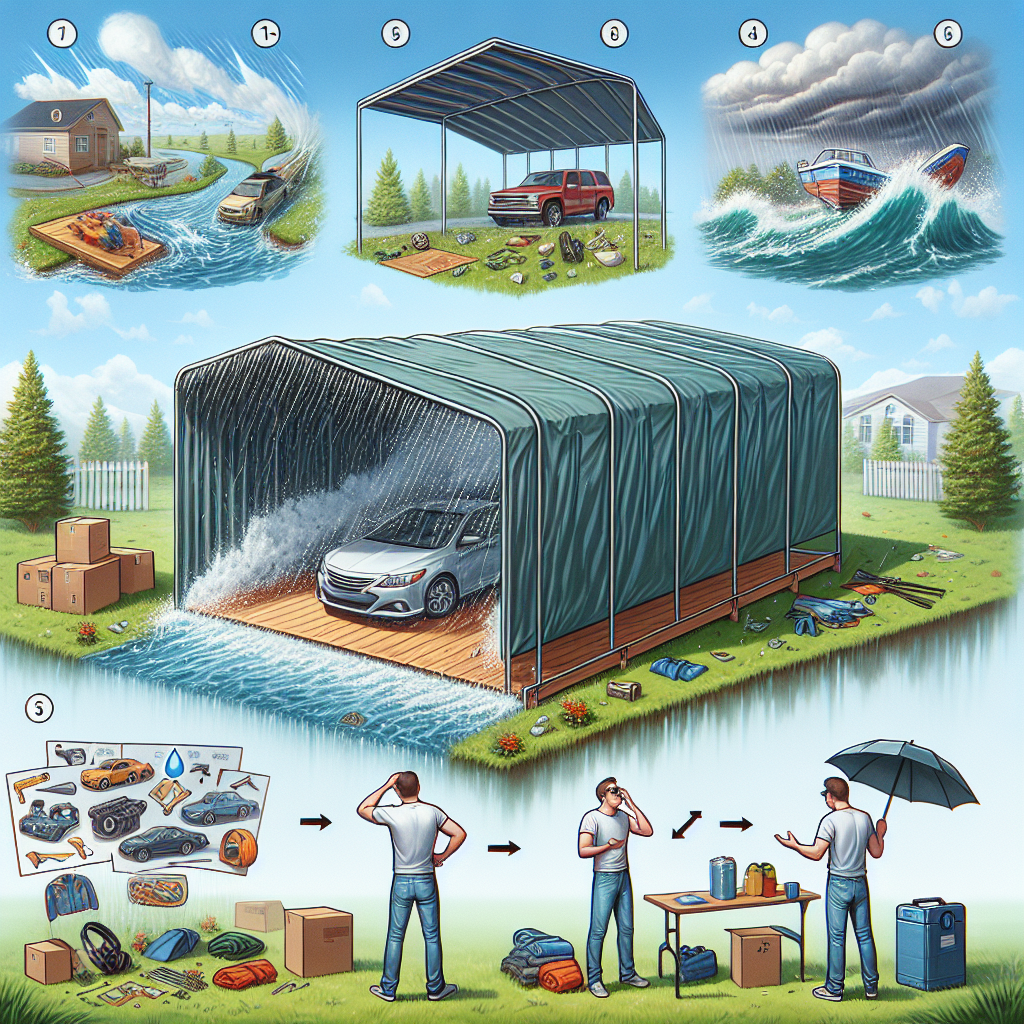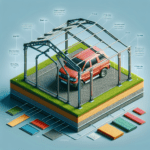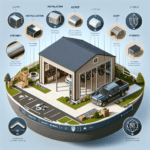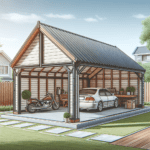Portable garages have gained popularity among homeowners and car enthusiasts for their convenience and versatility. However, it is crucial to be aware of the common drawbacks associated with these temporary shelters. From limited durability to potential water leaks, this article will shed light on the challenges you may encounter when relying on portable garages to protect your vehicles and belongings. Understanding these drawbacks will help you make an informed decision and ensure the long-term safety of your valuable assets.

Structural Limitations
Lack of Stability in High Winds
Portable garages are often made of lightweight materials that may not be able to withstand strong winds. As a result, these structures can be vulnerable to damage or even collapse during severe weather conditions. This lack of stability can be a significant drawback, especially in areas prone to frequent storms or high winds. It is essential to consider the potential risks associated with the structural limitations of portable garages before investing in one.
Vulnerability to Snow Loads
Another drawback of portable garages is their vulnerability to heavy snow loads. The lightweight materials used in their construction may not be able to support the weight of accumulated snow, leading to structural damage or collapse. In regions with significant snowfall, this limitation can pose a risk and may require frequent snow removal to prevent potential accidents or damage to vehicles or stored items.
Limited Lifespan
Portable garages generally have a shorter lifespan compared to permanent structures. The materials used in their construction are typically not as durable, causing them to deteriorate faster over time. While permanent garages can last for decades, portable garages may require replacement after just a few years. This limited lifespan can be a disadvantage for those looking for a long-term storage solution or a durable shelter for their vehicles.
Limited Storage Space
Difficulty in Storing Large Vehicles
One of the drawbacks of using portable garages is the limited space they offer for storing large vehicles. These structures often have size restrictions that can make it challenging to accommodate vehicles such as RVs, trucks, or boats. The confined space can lead to difficulties maneuvering the vehicle inside or potential damage during the storage process. It is crucial to consider the dimensions of your vehicle and the available space in a portable garage before purchasing or using one.
Insufficient Height for Tall Items
Portable garages typically have limited vertical clearance, making them unsuitable for storing tall items. Whether it’s equipment, machinery, or recreational gear, such as kayaks or canoes, the lack of height in these structures can pose a significant limitation. You may need to disassemble or modify your items to fit them inside the portable garage, which can be time-consuming and inconvenient.
Awkward Access to Stored Items
The design of portable garages can sometimes lead to awkward access to stored items. These structures often have a single, large opening that may not provide easy access to items located further inside. It can be challenging to retrieve objects stored towards the back, requiring you to rearrange or move other items. This limitation can be inconvenient, especially if you frequently need to access your stored belongings.
Inadequate Protection from Elements
Limited Waterproofing
Portable garages may lack proper waterproofing features, making them susceptible to leaks or water damage. The materials used in their construction may not provide sufficient protection against rain, leading to moisture buildup inside the structure. This can be particularly problematic for items that are sensitive to water, such as electronics or wooden furniture. Regular inspections and additional waterproofing measures may be necessary to minimize the risk of water-related damage in a portable garage.
Lack of Insulation
Another drawback of portable garages is their limited insulation properties. These structures often lack the insulation necessary to regulate temperature and protect stored items from extreme heat or cold. Without proper insulation, items stored inside the portable garage may be at risk of damage due to temperature fluctuations. Considerations should be made for items that require consistent temperature control, such as artwork or perishable goods.
Difficulty in Maintaining Temperature Control
Portable garages can present challenges in maintaining temperature control due to their lack of insulation and ventilation options. During hot summer months, the interior of the garage can become extremely hot, potentially damaging sensitive stored items. Conversely, in colder climates, portable garages may not offer sufficient protection against freezing temperatures, potentially causing damage to stored vehicles or equipment. Ensuring proper temperature control within a portable garage may require additional insulation or ventilation systems.
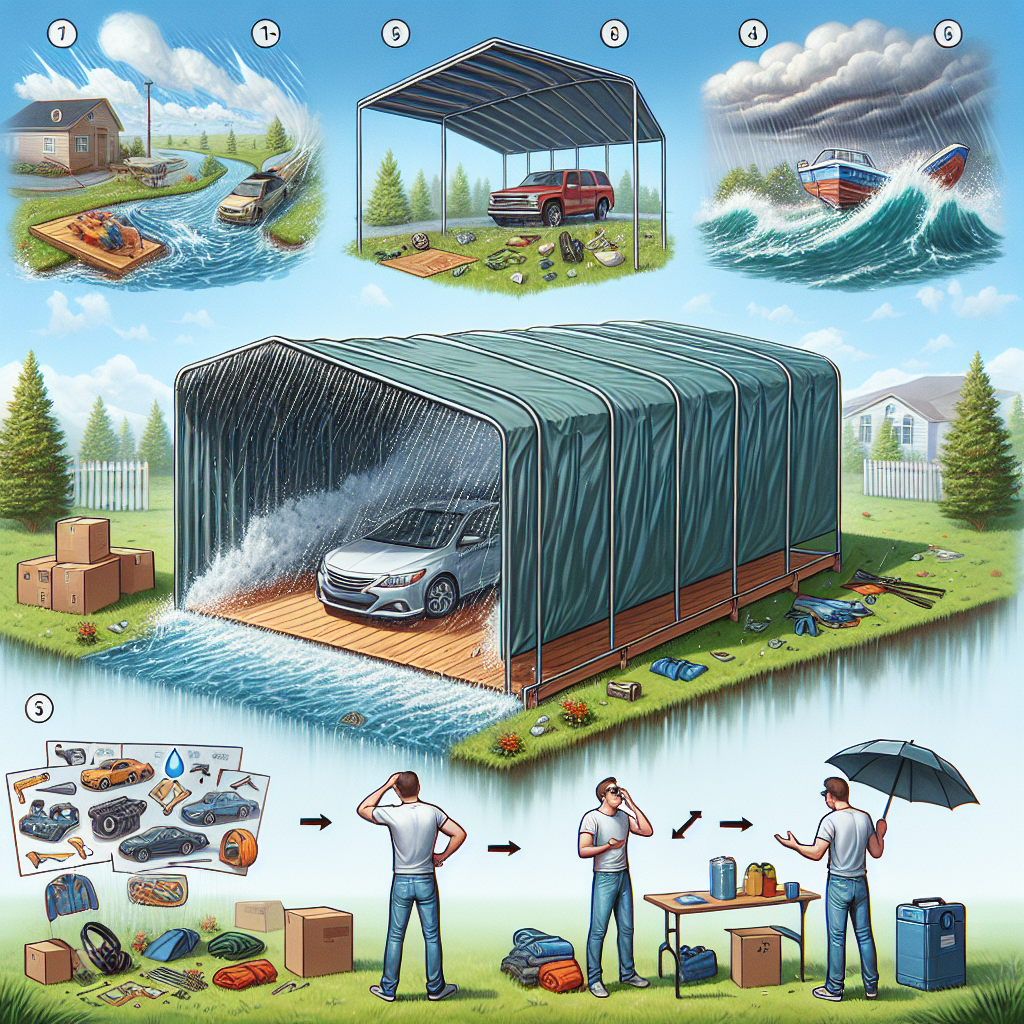
Vulnerability to Pests and Vermin
Easy Entry for Pests
Portable garages can provide easy access for pests and vermin. The materials used in their construction may have gaps or openings that allow insects, rodents, or other unwanted creatures to enter. Once inside, these pests can cause damage to stored items or create a breeding ground within the structure. Proper pest prevention measures, such as sealing gaps and using pest repellents, may be necessary to reduce the risk of infestations in a portable garage.
Lack of Pest Control Measures
Unlike permanent structures, portable garages often lack integrated pest control systems. This absence of preventive measures such as barriers, traps, or insect-repellent materials increases the likelihood of pest-related issues. Regular inspections and proactive pest control strategies should be implemented to mitigate the potential risks associated with using a portable garage.
Attractiveness to Rodents
Portable garages can be attractive to rodents due to the shelter and potential sources of food that they provide. These structures may inadvertently become a refuge for rats, mice, or other rodents seeking warmth and a safe environment. Rodents can cause significant damage to stored items, wiring, and insulation, compromising the structural integrity of the portable garage. Implementing rodent prevention methods, such as keeping the area clean and using repellents, can help minimize the risk of rodent infestation.
Potential Fire Hazards
Flammable Materials Used in Construction
Portable garages often utilize flammable materials in their construction, which can pose a fire hazard. The use of materials such as lightweight fabrics or plastic covers may increase the risk of fire accidents, especially if there are heat sources or electrical appliances stored inside the structure. It is crucial to exercise caution when using portable garages and avoid storing flammable or combustible items to minimize the risk of fire.
Limited Fire Suppression Systems
Unlike permanent structures, portable garages generally do not have built-in fire suppression systems. The absence of sprinklers or fire extinguishers increases the difficulty of containing or extinguishing a fire in case of an emergency. It is essential to have alternative fire suppression measures readily available, such as fire extinguishers or fire blankets, when using a portable garage to mitigate potential fire hazards.
Increased Risk of Spreading
Due to their lightweight construction and lack of fire suppression systems, fires in portable garages can spread rapidly. The materials used in these structures may easily ignite and contribute to the accelerated spread of flames. This increased risk of spreading makes it crucial to be vigilant and take prompt action in case of a fire. Regular inspections, proper storage practices, and awareness of fire safety protocols can help minimize the potential for fire accidents in a portable garage.
Limited Aesthetic Appeal
Lack of Design Choices
Portable garages often have limited design choices compared to permanent structures. These structures typically prioritize functionality and efficiency over aesthetics, resulting in a lack of customization options. The limited selection of colors, materials, and finishes can make portable garages stand out or clash with the surrounding environment. If visual appeal and integration with existing structures are important factors for you, exploring other storage options may be more suitable.
Unattractive Appearance
Portable garages are often not considered visually appealing due to their utilitarian design and construction materials. Their simple, box-like appearance may not blend harmoniously with the surrounding landscape or other structures. This lack of aesthetic appeal can be a drawback for those seeking a storage solution that enhances the overall appearance of their property.
Incompatibility with Surrounding Structures
The design and size limitations of portable garages can create compatibility issues with surrounding structures. These structures may not seamlessly integrate with existing buildings or landscaping, resulting in an unbalanced or disjointed appearance. If maintaining visual harmony within your property is important to you, alternative storage options that allow for more design flexibility and customization may be worth considering.
High Maintenance Requirements
Frequent Cleaning and Repairs
Portable garages may require frequent cleaning and repairs to maintain their functionality and appearance. The lightweight materials used in their construction may be more susceptible to wear and tear, requiring regular inspections and maintenance. Additionally, accumulated dirt or debris on the roof or walls can affect the structural integrity and lifespan of the portable garage. Dedication to ongoing cleaning and necessary repairs is necessary to ensure the longevity and performance of a portable garage.
Regular Replacement of Parts
The components of a portable garage may have a shorter lifespan compared to those found in permanent structures. The constant exposure to the elements, temperature fluctuations, and material fatigue can lead to the deterioration of various parts. Hinges, zippers, and fasteners may need to be replaced periodically to maintain the proper functioning of the structure. It is important to factor in the cost and availability of replacement parts when considering the long-term maintenance of a portable garage.
Costly Upkeep
The combined efforts of cleaning, repairs, and replacement of parts can result in significant upkeep costs for a portable garage. The regular maintenance requirements, combined with the shorter lifespan of these structures, can add up over time. Considering the ongoing expenses associated with using a portable garage is essential to ensure that it remains a viable and cost-effective solution for your storage needs.
Lack of Security
Easy Access for Thieves
One of the drawbacks of using portable garages is their vulnerability to theft. These structures often have simple locking mechanisms or may lack adequate security features, making them an easy target for thieves. Items stored inside portable garages, such as tools, equipment, or valuable belongings, may be at a higher risk of being stolen. Implementing additional security measures, such as installing stronger locks or surveillance systems, can help mitigate the risk of theft.
Insufficient Security Measures
Unlike permanent garages or storage facilities, portable garages may lack the built-in security measures necessary to protect stored items adequately. The lightweight materials used in their construction might not provide the same level of protection as more secure structures. This limitation can be a significant concern if you are storing valuable items or equipment in a portable garage. Evaluating and strengthening the security measures of a portable garage is crucial to ensure the safety of your belongings.
Risk of Vandalism
Portable garages can be more susceptible to vandalism due to their often isolated or remote locations. These structures may lack the protective measures commonly found in residential or commercial areas, making them an attractive target for malicious activities. Graffiti, damage to the structure, or theft of items stored within can occur if security precautions are not taken. Maintaining proper lighting, surveillance, and secure fencing can deter potential vandals and protect your portable garage from unwanted damage.
Limited Warranty and After-Sales Support
Short Warranty Periods
Portable garages generally have shorter warranty periods compared to permanent structures. The limited warranty coverage may not offer adequate protection against defects or premature failures. Additionally, the warranty may not cover damage caused by external factors such as severe weather or accidents. It is crucial to carefully review the warranty terms and conditions before purchasing a portable garage and consider any additional coverage options that may be available.
Limited Manufacturer Support
Portable garages often come from manufacturers that may have limited customer support services. Obtaining assistance or resolving issues related to the structure, parts, or warranty claims can be challenging. Extended wait times or difficulty obtaining replacement parts or repairs may be common, resulting in prolonged inconveniences. It is important to assess the manufacturer’s reputation for after-sales support when considering a portable garage as a storage solution.
Difficulty in Finding Spare Parts
Finding spare parts for portable garages can be problematic due to limited availability or compatibility issues. The specific design and construction of each manufacturer’s portable garages can result in unique parts requirements. This lack of standardization may make it challenging to source replacement parts or accessories, potentially impacting the usability or functionality of the structure. Considering the potential difficulties in finding spare parts is crucial to ensure the long-term maintainability of a portable garage.
Environmental Concerns
Non-Biodegradable Materials Used
Many portable garages are constructed using non-biodegradable materials, such as synthetic fabrics or plastics. This can pose environmental concerns, as these materials may take hundreds of years to decompose, contributing to landfill waste. The accumulation of discarded portable garages can have a negative impact on the environment, both in terms of resources used for their production and the difficulty in their disposal. It is important to be mindful of the environmental consequences when opting for a portable garage as a storage solution.
Potential Harmful Runoff
Portable garages often lack proper drainage systems, which can lead to harmful runoff during heavy rains. The accumulation of water, along with any debris or contaminants present on the structure, can result in runoff that may pollute the surrounding soil or water bodies. This can have adverse effects on ecosystems and pose a risk to human health. Considering the potential environmental impact and implementing proper drainage measures can help mitigate these concerns.
Lack of Sustainable Features
Portable garages typically do not incorporate sustainable features commonly found in permanent structures, such as renewable energy sources or energy-efficient design. These structures may have a higher carbon footprint due to the use of non-renewable materials and energy during their production. If sustainability is a priority for you, exploring alternative storage options that offer greater eco-friendliness and sustainable features may be a more suitable choice.
In conclusion, while portable garages provide a convenient and relatively affordable storage solution, they come with several drawbacks. From structural limitations to limited warranty and after-sales support, these factors need to be carefully considered before investing in a portable garage. Whether it’s the lack of stability in high winds, limited storage space, inadequate protection from the elements, increased vulnerability to pests and vermin, or concerns about fire hazards and environmental impact, it is essential to evaluate whether a portable garage aligns with your specific needs and preferences. Exploring alternative storage options that address these drawbacks and offer greater security, durability, and aesthetic appeal may be worth considering for those seeking a long-term storage solution.

